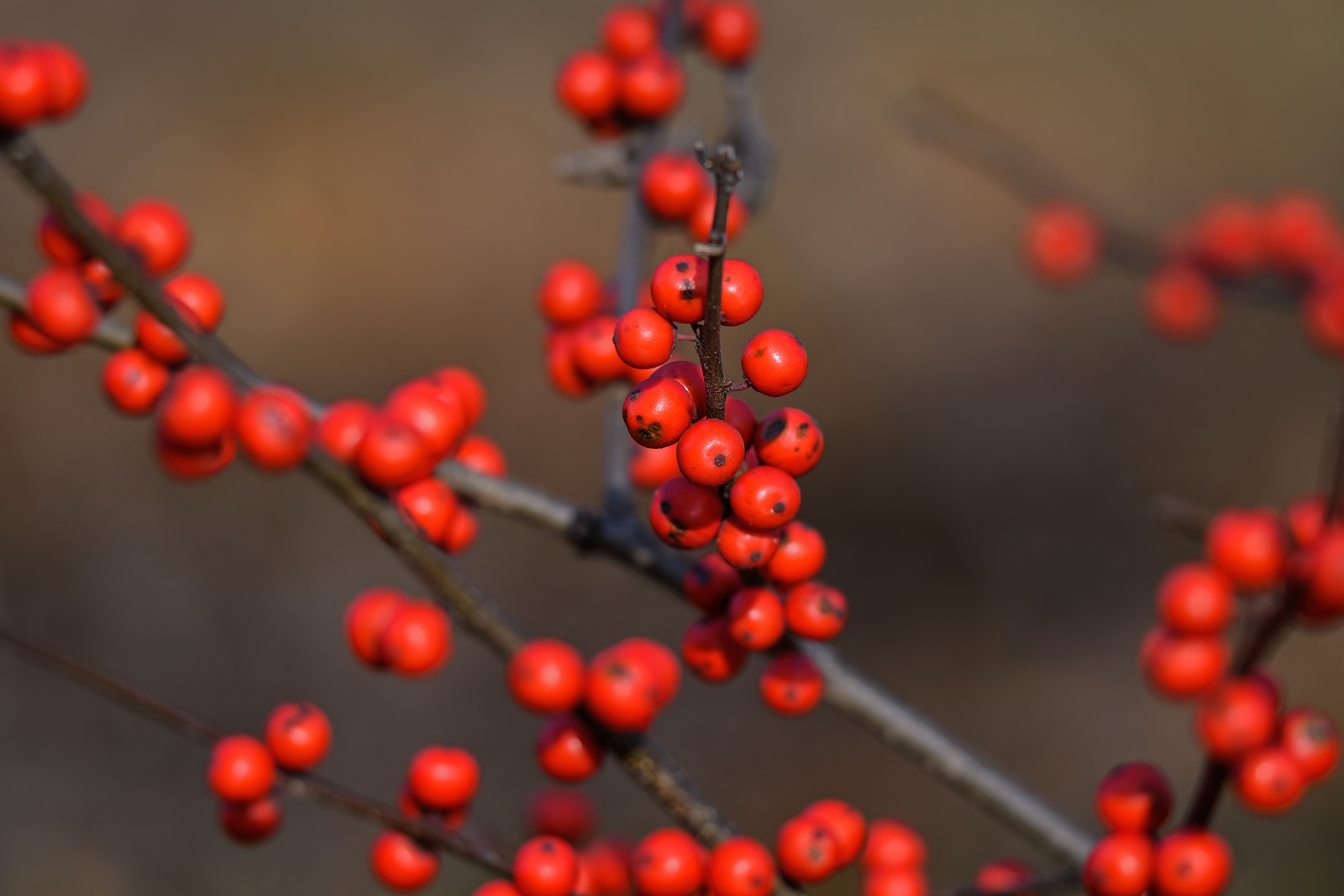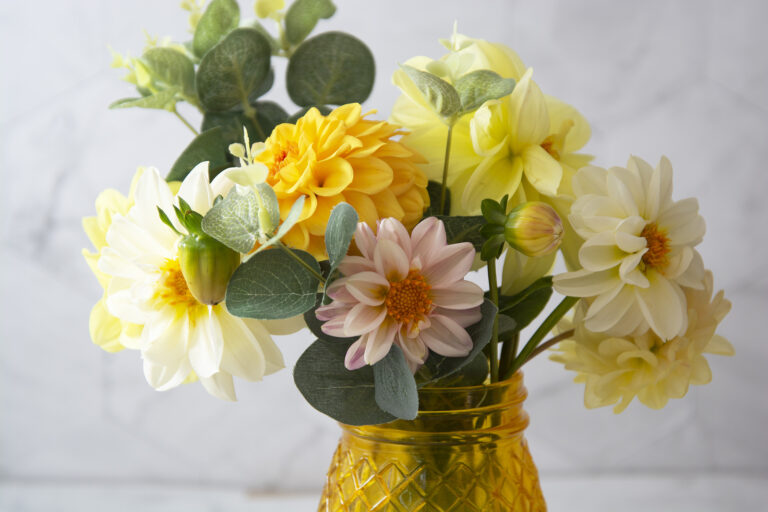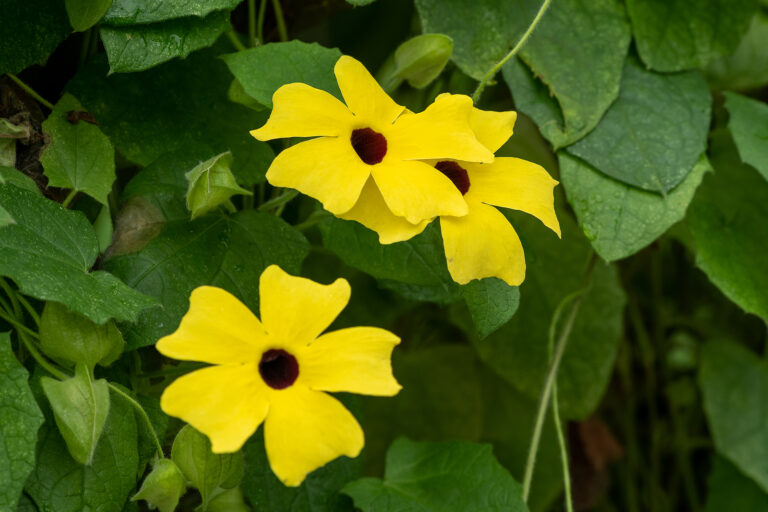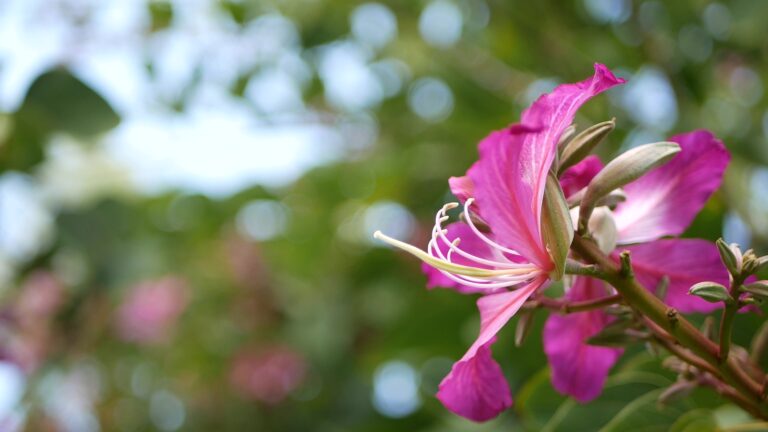Shrubs with Showy Berries
Many shrubs are grown for their attractive colored berries or fruit that commonly appear in autumn or winter. Some varieties produce more abundant crops than others. The right growing conditions are important for berry and fruit production.
Some shrubs produce male and female flowers on separate plants (these are referred to as dioecious). Cross-pollination must occur for berries and fruit to form. Plant dioeious shrub–such as hollies–in groups of three or more females with a male at the center of the group. Check nursery can labels to know if you are purchasing a male or female plant.
Weather conditions can affect the number of berries on a plant each year. If the weather is dry at flowering times or as berries are forming, either the flowers or fruit will drop prematurely. Where weather is dry keep the soil evenly moist. Frost at flowering time can prevent the formation of fruit altogether.
Many gardeners grow shrubs with showy fruits not only to bring late season color to the garden but to attract birds to the garden. Autumn and winter berries will draw birds. Practicing organic methods in your garden will have a beneficial effect on birds and other wildlife.
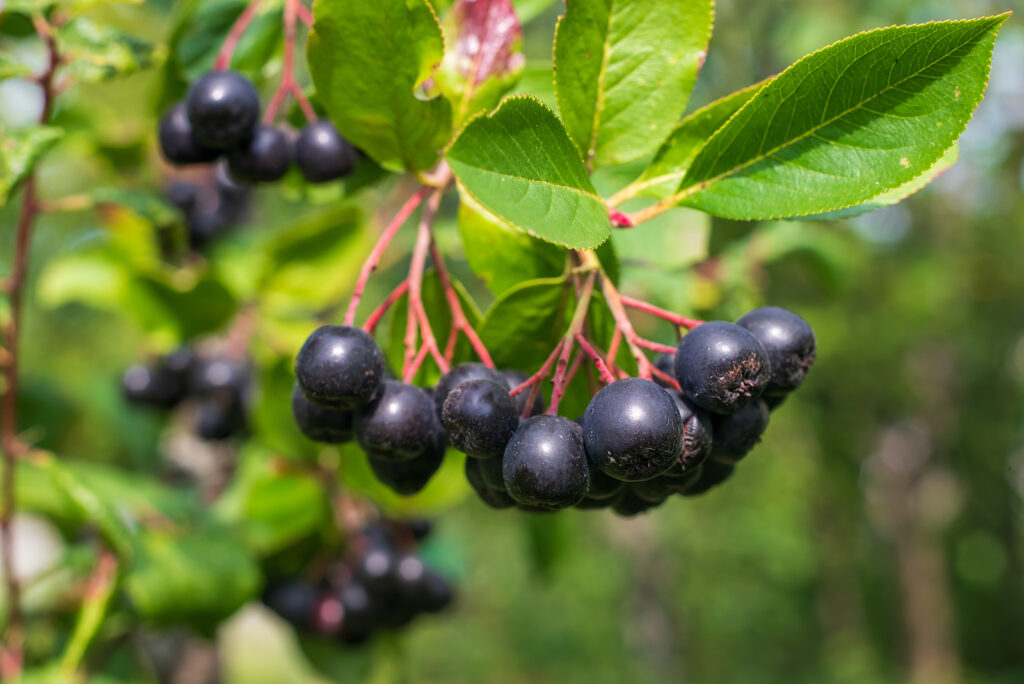
Black berries
Aronia melanocarpa (black chokeberry). Deciduous upright shrub with frothy white flowers in spring, food fall color, and fruits that attract birds. Grows 6 to 8 feet tall and 5 feet wide. Plant in average soil in full sun. Foliage turns red and purple in fall. Black berries are not bitter. Grows in moist soil. Zones 4-9.
Mahonia spp. (holly grape). Evergreen shrub with green to blue-green leaves; in fall some species and varieties turn purplish or bronze. Mahonia aquifolium (Oregon grape) (Zones 4-8) grows 3 to 4 feet tall and wide; M. japonica (Zones 7-9) grows 6 to 10 feet tall and nearly as wide. Plant in average soil in partial shade. Both produce yellow flowers in spring followed by black berries in autumn.
Osmanthus heterophyllus (holly osmanthus). Evergreen shrub with hollylike, finely toothed or smooth-edged leaves. Small greenish-white blossoms in early summer are intensely fragrant. Grows 18 feet tall and 6 to 10 feet wide. Plant in average garden soil in full sun or partial shade. Bluish-black fruits appear in early fall. Zones 7-9.
Viburnum tinus (Laurustinus viburnum). Evergreen shrub with shiny green leaves. Flowers in mid to late summer often have a pink hue. Grows 10 feet tall and 8 to 10 feet wide. Plant in average garden soil in full sun or partial shade. Blue-black berries appear in autumn. Zones 7-10.

Blue, purple, or lavender berries
Callicarpa spp. (beautyberry). Deciduous shrub with tubular flowers that open in summer; berry clusters put on a good display after leaves turn yellow and drop in autumn. Callicarpa bodinieri giraldi has small lilac-colored flowers and bluish-violet berries that hold into winter; it grows to 8 feet tall and 6 feet wide. Callicarpa dechotoma has pink flowers and lilac to violet berries; it grows 4 feet tall and wide. Plant both in average garden soil in full sun. Zones 5-8.
Symplocos paniculata (sapphire berry). Deciduous upright, bushy shrub with fragrant, star-shaped white flowers in spring followed by bright blue berries. Grows 15 feet tall and wide. Plant in humus-rich, well-drained soil in full sun. Berries appear in autumn. Zones 5-8.
Viburnum lentago (nannyberry). Large deciduous shrub. Small flowers are usually white and develop in attractive flat clusters; blue-black berries follow in autumn. Grows 12 feet tall and 8 feet wide. Birds are attracted to fruit and rapidly devour them. Plant in average garden soil in full sun or partial shade. Zones 2-8.
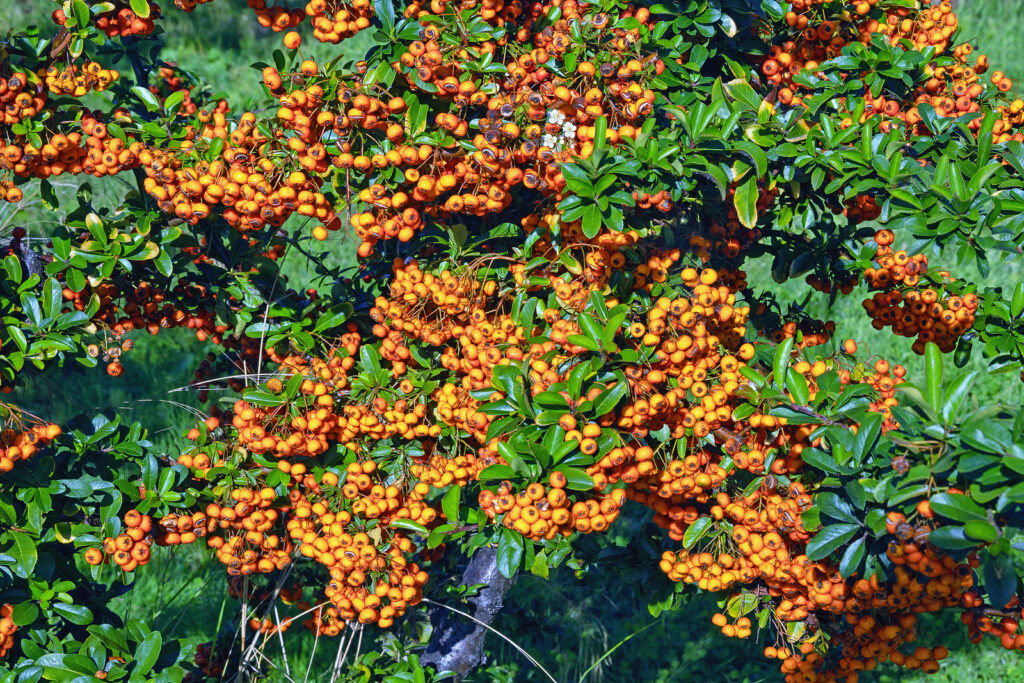
Coral or orange berries
Euonymus europaeus (European spindle tree). Deciduous conical-shaped shrub with spreading somewhat pendent shoots. Dark green leaves turn red in autumn. Grows10 feet tall and 8 feet wide. Plant in average garden soil in full sun or partial shade. Spherical berries in autumn are red. Zones 4-7.
Ilex verticillata ‘Aurantiaca’ (winterberry). Deciduous shrub bears white flowers. Spherical orange berries appear in autumn. Grows 6 feet tall and 4 feet wide. Plant in average garden soil in full sun or partial shade. Plant male and female plants for berries. Zones 3-9.
Pyracantha coccinea ‘Soleil d’Or’ (fire thorn). Evergreen upright shrub with red-tinged shoots. Small white flowers in spring. Grows 10 feet tall and 8 feet wide. Plant in average garden soil in full sun or partial shade. Coral autumn berries can remain on the plant through most of the winter. Zones 8-10.
Symphoricarpos X chenaultii (Chenault coralberry). Vigorously branching deciduous shrub. Grows 3 feet tall and 8 feet wide; good hedge plant. Plant in average garden soil in full sun or partial shade. Coral berries are white on the shaded side. Zones 4-7.
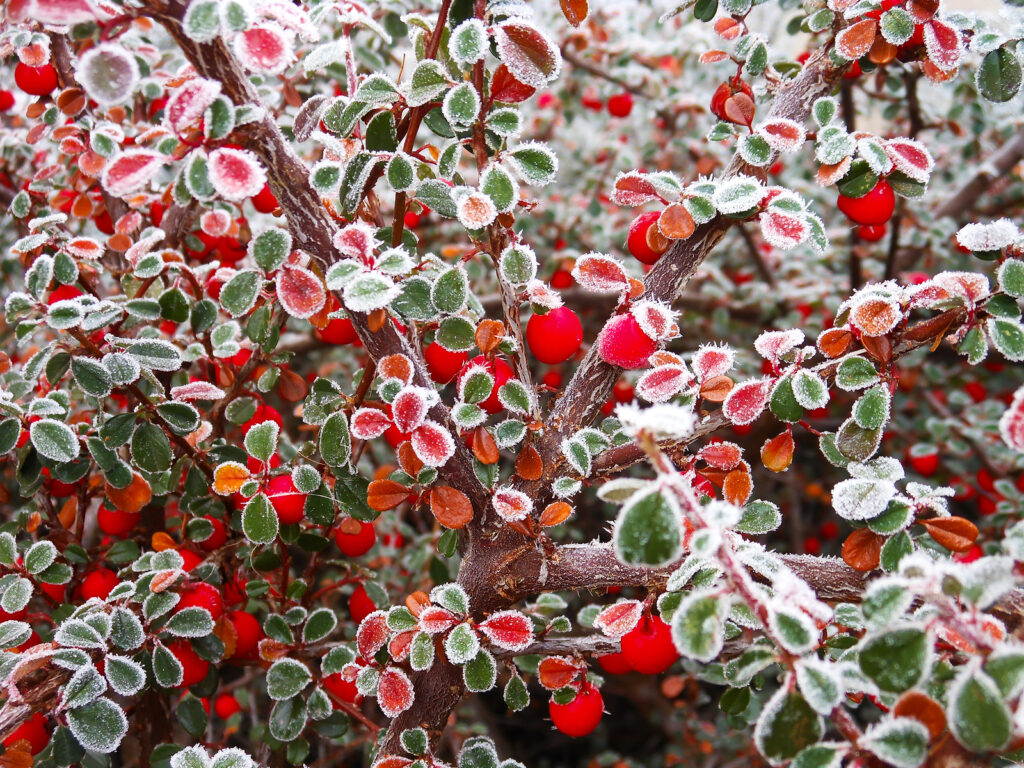
Red berries
Aronia arbutifolia (red chokeberry). Deciduous upright shrub with dark green leaves that turn scarlet in autumn. Grows 6 to 8 feet tall and 5 feet wide. Plant in average garden soil in full sun. Berries attract birds. Zones 4-9.
Aucuba japonica (Japanese laurel). Densley leaved evergreen shrub with shiny, often variegated leaves. Grows 12 feet tall and 7 feet wide. Plant in average garden soil in full sun where summers are not too hot or in shade. Bright red berries appear on female plants in autumn and last until spring. Plant male and female plants for berries. Zones 7-10.
Berberis spp. (barberry). There are both evergreen and deciduous varieties of Berberis; some mature at 2 feet tall and wide and others grow from 5 to 8 feet tall and nearly as wide. Plant in average garden soil in full sun or partial shade. Berberis flowers are yellow and appear in spring; berries follow in autumn. Zones 4-8.
Cotoneaster spp. (cotoneaster). Both deciduous and evergreen varieties of this mostly lower growing shrub that bears small white or pinkish flowers in spring or summer. Cotoneaster is often grown for its attractive branching pattern and the small red berries that make a showy display in fall. Grows from 2 to 6 feet tall depending on the variety and 3 to 10 feet wide or more depending on the variety. Plant in average garden soil in full sun or partial shade. Berries are usually scarlet. Zones 2-9 depending on the variety.
Ilex spp. (holly). Most Ilex varieties are evergreen. Glossy, dark green leaves with greenish or white flowers. Berrylike fruits appear on female plants. Ilex responds well to shearing. Most varieties grow 5 to 10 feet tall and 4 to 8 feet wide. Plant in average garden soil in full sun or partial shade. Autumn berries are scarlet. Plant male and female plants for berries. Zones 4 to 9 .
Nandina domestica (heavenly bamboo). Evergreen upright shrub is not a bamboo, but more closely related to barberries. Grows 6 to 8 feet tall and 4 to 6 feet wide. There are dwarf cultivars. Plant in average garden soil in full sun. Berries appear in autumn and hold on plant into winter. Zones 6-9.
Photinia spp. (photinia). Evergreen shrub wit upright, spreading habit bears leathery evergreen foliae, abundant white flower clusters, and in autumn red berries. Grows 10 to 15 feet tall and 6 to 10 feet wide. Makes a dense hedge or screen. Grow in average garden soil in full sun. Zones 7-9.
Pyracantha coccinea (fire thorn). Evergreen upright shrub with red-tinged shoots. Small white flowers in spring. Grows 15 feet tall and 15 feet wide. Plant in average garden soil in full sun or partial shade. Produces heavy crop of brilliant red berries that remain on the plant through most of the winter. Zones 6-9.
Rhus spp. (sumac). Deciduous shrub grown for its leaves which turn fiery red in autumn. Flowers are generally greenish yellow. Most varieties grow 10 to 20 feet tall and 6 to 10 feet wide. Plant in average garden soil in full sun. Brillian red berries appear in tight vertical clusters. Zones 2-7.
Skimmia japonica (Japanese skimmia). Evergreen shrub with spreading habit; leaves are aromatic when crushed bears small clusters of creamy white flowers. Grows to 4 feet tall and 5 feet wide. Plant in regular garden soil in partial shade. Red berries are similar to holly. Zones 6-8.
Viburnum trilobum. (high-bush cranberry). Deciduous spreading shrub bear small usually white flowers in ball-like terminal clusters. Handsome fall color. Grows12 feet tall 10 feet wide. Plant in average garden soil in full sun or partial shade. Berries are bright red and last into winter. Zones 2-7.
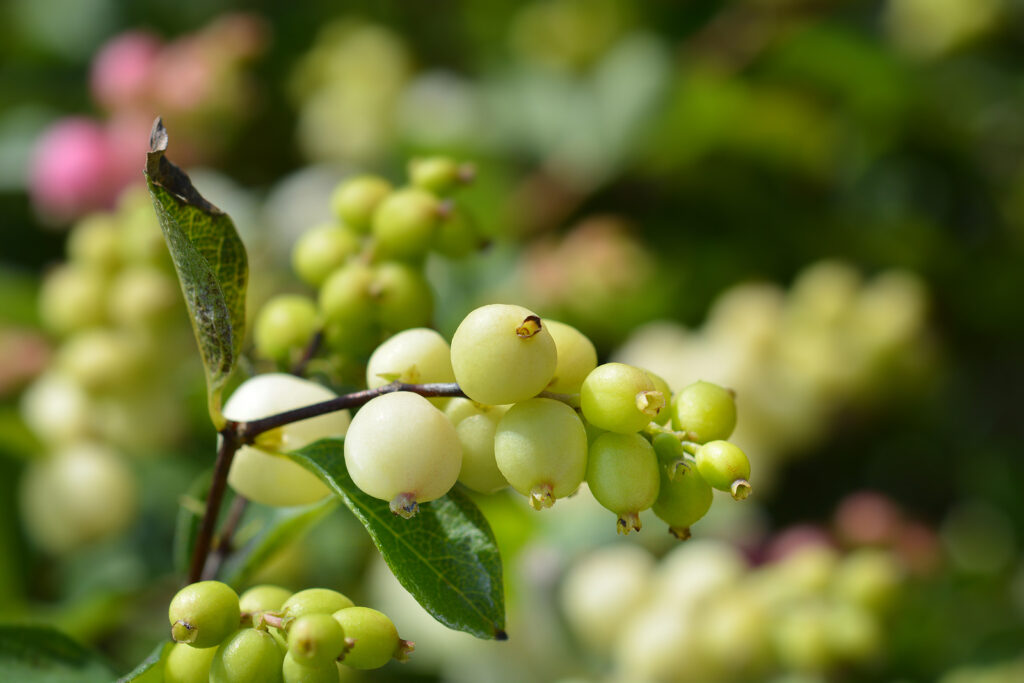
White or silvery grey berries
Callicarpa japonica ‘Leucocarpa’ (Japanese beautyberry). Bushy, deciduous shtrub bear pink or white flowers in late summer. Grows 6 feet tall and wide. Plant in average garden soil in full sun. Cultivar ‘Leucocarpa’ bears white berry fruits in autumn. Zones 5-8.
Myrica pensylvanica (barberry). Large, rounded deciduous shrub bears yellowish green ctakins followed by waxy white fruit. Grows 9 feet tall and 5 to 12 feet wide. Plant in humus-rich soil in full sun. Plant male and female plants for berries. Zones 3-6.
Symphoricarpos albus (snowberry). Deciduous, vigorously branching shrub bears very small flowers in early summer. White berries form in abundance in early fall, bending branches to the ground. Grows 3 to 4 feet tall and 6 feet wide. Plant in average garden soil in full sun or partial shade. Zones 3-7.
Yellow or gold berries
Ilex verticillata ‘Winter Gold’ (winterberry). Deciduous shrub bears white flowers. Spherical gold berries appear in autumn. Grows 8 to 10 feet tall and 10 feet wide. Plant in average garden soil in full sun or partial shade. Plant male and female plants for berries. Zones 5-8.
Viburnum opulus ‘Xanthocarpum’ (European cranberry bush). Bushy deciduous shrub with maple-like, dark green leaves that turn red in autumn. Bears flat lacy-cap white flowers i summer followed by yellow-gold berries in autumn. Grows to 15 feet tall and 12 feet wide. Plant in average garden soil in full sun or partial shade. Zones 3-8.
Also of interest:

